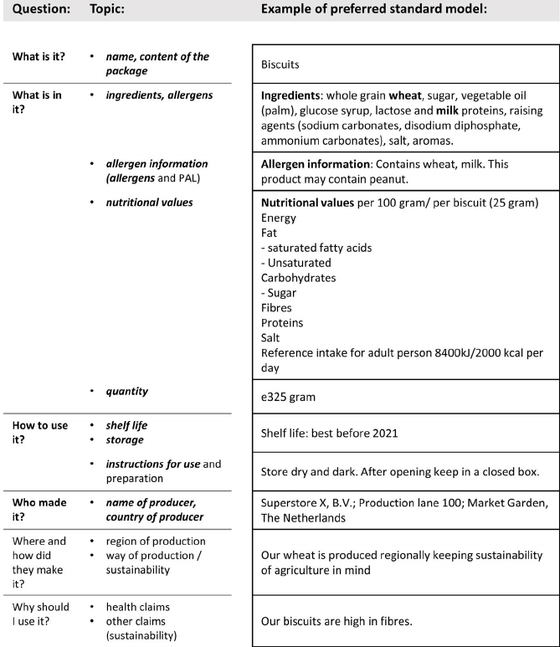Feb 19: Food labels can be much clearer
Feb 19: Food labels can be much clearer

Walk into a random supermarket and you will be overwhelmed by the sheer diversity of products and labels. This may not be a problem for most people, but if you have a food allergy or have to cook for someone who does, it is. The numerous labels all display the allergy information in a different way, which certainly does not help the customer when trying to find out if they can eat the product or not. Communication experts from the Faculty of Humanities as well as experts from University Medical Center (UMC) Utrecht and the Netherlands Organisation for Applied Scientific Research (TNO) have joined forces to come to a joint proposal for a food label which makes it much easier for people with a food allergy or intolerance to identify the information they need.
“At TNO and UMC Utrecht, we found that patients regularly present unexpected allergic reactions from eating certain products. One of the causes turned out to be inadequate food labelling, which should be an important if not the most important way for a consumer to decide whether the product is safe to consume”, says investigator Marty Blom (UMC Utrecht and TNO). “It was, therefore, a no-brainer to start the collaboration with allergologist André Knulst and communication experts Bregje Holleman and Leo Lentz on the improved food labelling. The project unites the knowledge available in the three separate groups.”
Collaboration
The collaboration with TNO and UMC Utrecht ran very smoothly, says Professor of Document Design and Communication Leo Lentz . “As communication experts, we knew a lot about text, communication, corpus research and experiments, but nothing at all about allergies, allergy information, clinical practice or legislation. Our panel of experts, however, has demonstrated to be very knowledgeable about all this. It took a little time to learn to understand each other and each other’s language and to combine this into scientific publications, but it was all worth it.” Bregje Holleman, Associate Professor Language and Communication, adds: “For us, as communication experts, it was the first time that we were published in a medical journal. For Marty Blom, the term ‘corpus study’ was completely new. In her world, a corpus simply means a body; for us, it is a set of texts that is systematically studied.”
Collaborating with disciplines that you do not typically work together with inspired me as I realized that we complement each other and can bring about something unique. In practice, it means that you really have to communicate about the details. When within your own discipline a few words often suffice, you now have to carefully explain certain things to the experts from another field of expertise.
Clinical & Experimental Allergy
It was a conscious choice to publish the article in Clinical & Experimental Allergy, explains Marty Blom. “Our international stakeholders read these journals. The improvement of the safety of food-allergic patients involves many parties: manufacturers, legislators providing the frameworks, doctors and nutritionists advising the patients and, last but not least, the food-allergic patients themselves. All of them are regularly in contact with each other and collaborate in projects to improve the current situation.”
Food labels are like puzzles
Research shows that food labels could be much clearer. “They are often like puzzles, in which sometimes the texts are unreadable as a result of, for instance, transparent packaging with white letters against a yellow background. Moreover, the order of the relevant information is almost always slightly different from that on another label”, explains Leo Lentz. “We have analyzed over 300 food labels in supermarkets against a range of aspects that influence the findability and understanding of the information for consumers with a food allergy or intolerance. Colleagues from the UMC Utrecht and TNO assisted in the interpretation of the labels and indicated the issues that the patients encounter in their daily lives.”
‘May contain peanuts’
The Dutch and European legislation concerning food labels is readily available but allows much room for interpretation by the manufacturers and supermarkets. Before she started studying the food labels, Bregje Holleman had not realized the current wide diversity in formulations: “Labels may state that the product was ‘Produced in a facility that also processes peanuts’, but also that the product ‘May contain peanuts’. Do these statements mean something different? Should you refrain from eating either product if you have a food allergy or not?” “Experts at TNO were able to tell us communication experts everything about the relevant legislation”, adds Leo. “Previously, I did not think twice when reading formulations such as ‘May contain peanuts’, but now I know they mask a whole world of European and Dutch legislation.”
Optimal food labels
In close collaboration, the researchers wrote a proposal for an optimal food label that allows the easy identification of the relevant information by people with food allergies and intolerances (see picture at the bottom of this article). They also provided six recommendations for the industry to start implementing. These suggestions are not only relevant in the Netherlands but to food labelling industries worldwide.
Current allergen information causes problems
“We have made a first step towards more awareness by government and industry that the current allergen information is causing problems to food-allergic patients and the people that shop for them”, explains Marty Blom. “However, a food label is not a medical insert, it is also a means of communication for the manufacturers. As a result, the label must allow sufficient leeway to provide other information. Our recommendations enable individual companies to take some first concrete steps (think of readability), but in order to realize genuine improvements for this group of patients, the standardization of all the information is crucial.”
Six recommendations to improve the communication concerning the food allergen information:
- Ensure all food information is readable (with an appropriate background)
- Present allergens in the ingredient list in bold
- Provide a grouping of related topics and a uniform topic order on the label.
- Provide an allergen information section
- Use one uniform statement for PAL (PAL = Precautionary Allergen Labelling, such as ‘May contain peanuts’)
- Use of allergen icons
Further research
Soon, a report on two experiments researching the interpretation of allergy information conditional to specific formulations will be published. Do people rate ‘May contain peanuts’ as riskier than ‘Produced in a facility that also processes peanuts’? The study also comprises a range of interviews with food manufacturers and retailers: what is the reason for making it so that the way allergy information is being displayed reveals such a wide variation between manufacturers, brands and products? How does a manufacturer even know whether there is a risk that a product contains an allergen? How do they decide in what way the consumer should be warned about this? Eventually, the researchers intend to provide a complete overview of the rationale (or the lack thereof) behind the allergy communication and to come up with concrete recommendations to improve this.
Publication
Blom WM, van Dijk LM, Michelsen-Huisman A, Houben GF, Knulst AC, Linders YFM, Verhoeckx KCM, Holleman BC, Lentz LR. Allergen labelling: Current practice and improvement from a communication perspective. Clin Exp Allergy. 13 January 2021. https://doi.org/10.1111/cea.13830

Text: Femke Niehof (Utrecht University)

